Patriots Scatter the Last Tory Army
Location
Other maps: Bing, Google, Mapquest.
Coordinates: 34.8070, -79.1441.
Type: Sight
Tour: Tory War
County: Robeson
You can park anywhere on the shoulder at our first stop. But because it may be overgrown in warmer months, the coordinates mark a narrow mailbox pullout on Old Lowery Road. It should be approached from NC 211 (the direction taken by Patriot forces in the battle). Look for it on the right just after crossing the Little Raft Swamp bridge.
Larger vehicles may not fit. If yours can’t, read down to, and then follow the directions to, the second stop at Dixie Road.
Context
 With the encouragement of Continental leaders, in August 1781 the North Carolina government ordered a militia general to drive British occupiers out of Wilmington.
With the encouragement of Continental leaders, in August 1781 the North Carolina government ordered a militia general to drive British occupiers out of Wilmington.
Situation
Tory
Before the campaign could launch, a Loyalist (“Tory”) army captured Gov. Thomas Burke and other Patriot government officials in Hillsborough in September and transported them to Wilmington. This was the army of Col. David Fanning, who was out of action while recovering from his wounds suffered at the Battle of Lindley’s Mill. Now under Col. Duncan Ray and Col. “One-Eyed” Hector McNeill, it was camped at McPhaul’s Mill, south of modern Fayetteville. Joined by locals, the army had grown to between 300 and 600 and was drilling for further action when the colonels learned of the approach of a much larger Patriot force. The Tories retreated to a stronger defensive position behind Little Raft Swamp.
Patriot
Brig. Gen. Griffith Rutherford was on the move toward Wilmington. He learned about the Tory camp and marched his army of at least 950 men, perhaps as many as 1,400, towards it. He sent cavalry ahead under Maj. Joseph Graham in hopes of pinning the Tories down at the mill until the main army could arrive. But the Tories had already withdrawn. Graham followed them here.
Date
Monday, October 15, 1781.
Timeline
Imagine the Scene
Charging Through the Swamp
You can remain in your vehicle. Look behind you.
You just crossed Little Raft Swamp. A wooden bridge was located where the modern one is. You watch as Tory militia tear up the planks and grease the supporting logs. Then a number of them crowd into the road on their “Scotch ponies,” prepared to defend the crossing. More men are uphill. Given the swamp; the removal of the bridge deck; and their holding both the high ground and the road, the Tories are confident of their position. They don’t bother to dismount and form a proper defensive line. The horses stamp and snort next to your window as the men talk.
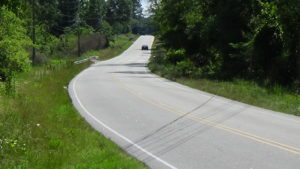
Late in the afternoon, two Tory scouts appear sprinting toward you and plunge directly into the swamp. Close behind them, a large troop of Patriot (“Whig”) cavalry thunder into view down the road. To the surprise of everyone around you, the dragoons spread out across the far hill and ride right into the swamp!
Most of the Loyalists struggle to turn their horses, and break for the rear in disorder. The first of the Patriots bring their horses up onto the causeway from both sides. They begin swinging sabres at Tories who are trying to squeeze up toward you in a panic. Once the road clears, the Patriots move past you in force.
A Running Battle
Drive up the road to the first cross street, and turn right onto Dixie Road. Park in the lot on the left such that you can see in both directions along Old Lowery Road, a dirt road at the time.
 At least three dozen Tories (one source says 150) try to form a defense, probably in a line here at the crest. Once the Patriots have gotten through the swamp, they spread out into their own line, perhaps where the tree line is down the hill today. When they charge, the Tory line breaks, in part because these men are unaccustomed to fighting from horseback.
At least three dozen Tories (one source says 150) try to form a defense, probably in a line here at the crest. Once the Patriots have gotten through the swamp, they spread out into their own line, perhaps where the tree line is down the hill today. When they charge, the Tory line breaks, in part because these men are unaccustomed to fighting from horseback.
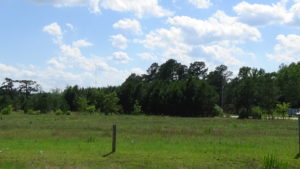
All over the hill, Patriot sabres flash, pistols fire, and Tories fall from their horses. Some fight back. Most run up the road while others scatter to the sides. A running battle spreads across the hill.
An innocent traveler has happened upon the scene. Though at first unafraid, since he isn’t involved, he gets scared when the Patriots charge. He goes to his knees somewhere within your view along the dirt road and begs to be spared. But a Patriot shoots him without slowing down.
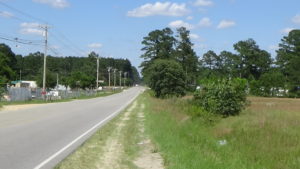
Little Scotch Ponies
Turn right onto Old Lowery. Drive across the hill and down the other side. At the bottom you will see another bridge. Pull off onto the shoulder as close as you like.
 You are looking at Raft Swamp. The Tories are crowding the causeway supporting the road, desperately trying to get across the wooden bridge here at the time. As you watch, the approach becomes clogged. Many Tories begin plunging their small horses into the swamp on both sides. The Patriots approach from behind, firing pistols into the throng and following onto the causeway. Other Loyalists fall or jump into the swamp, leaving their ponies behind.
You are looking at Raft Swamp. The Tories are crowding the causeway supporting the road, desperately trying to get across the wooden bridge here at the time. As you watch, the approach becomes clogged. Many Tories begin plunging their small horses into the swamp on both sides. The Patriots approach from behind, firing pistols into the throng and following onto the causeway. Other Loyalists fall or jump into the swamp, leaving their ponies behind.
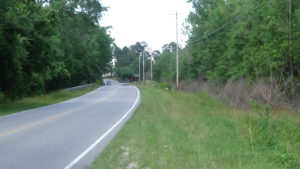
Eventually the Whig dragoons are halted by the equine traffic jam. Several dismount and begin shoving horses into the swamp to clear the road. One participant later told Rev. Eli Caruthers, who wrote a war history in the 1850s after interviewing veterans: “‘It looked funny’ to see the little Scotch ponies that had been jostled off the causeway, and had sunk into the water on each side, some with only their noses above the surface.’”[1]
Caruthers says Patriots are looking at the ponies when they notice an older Scot hiding among the leaves. Beckoned out, he gestures for them to spare him, apparently only speaking Gaelic. Some of the Whigs want to shoot him, but others talk them down. Then Maj. Charles Polk arrives, nicknamed “Devil Charley.” The Scotsman realizes from this man’s manner that he will offer no mercy, and takes off toward the swamp. Polk rides after him and slices his head open. As he returns, he wipes the blood from his sword with his hand.[2]
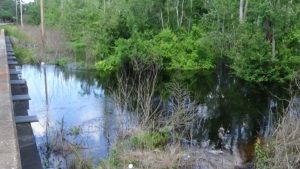
The Patriots eventually continue up the road. They search the swamps in the area into the night. Finally around 10 p.m., a bugle sounds to call them back, and they return to McPhaul’s Mill.
Battle Map
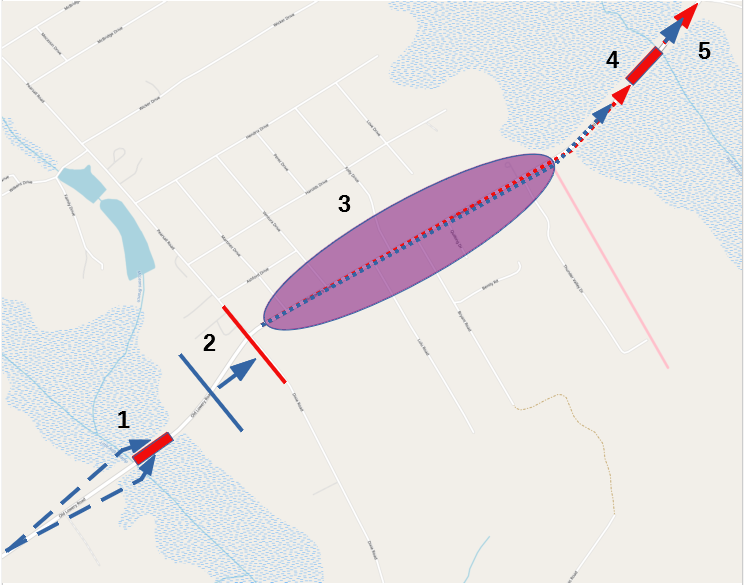
The Battle of Raft Swamp. Troop locations on the hill are approximate. 1) Patriot cavalry ride into swamp and drive back Tories. 2) Some Tories form a line; Patriots form and charge, breaking it. 3) A running battle spreads across the hill. 4) Tories and their horses create a traffic jam, cleared by Patriots. 5) Tories flee and Patriots give chase.
Casualties
- Loyalist Militia: 16 killed, 50 wounded, 15-20 captured.
- Patriot Militia: 1 killed.
After the Battle
The Patriot cavalry returned the next day under Rutherford’s orders and continued the search. When Rutherford arrived on the scene, he ordered them to spread out in all directions. Many Tories surrendered, but others feared a massacre and fled, some as far as South Carolina.
This battle dispersed the last large Loyalist army in North Carolina, though the Tory War would continue between smaller units for another six months.
Historical Tidbit
Local historian John McPhaul wrote that in 1966, he saw bones in construction holes dug at the northeast corner of Old Lowery Road and McLeod Road (the first crossroad on the other side of NC 211 from the battlefield). Later he was told local tradition held that some of those who fell in Lowery Road were buried there, and the cemetery still bore wood markers into the 20th Century.[3]
More Information
- Caruthers, E. W. (Eli Washington), Interesting Revolutionary Incidents and Sketches of Character, Chiefly in the ‘Old North State.’ (Philadelphia : Hayes & Zell, 1856) <http://archive.org/details/interestingrevol00incaru> [accessed 23 April 2020]
- Jacobs, Ben, ‘The Battles of McPhaul’s Mill and Raft Swamp, 1781’, Cape Fear Clans, 1977 <http://www.capefearclans.com/ColonialMuster.html> [accessed 26 January 2020]
- Lewis, J. D., ‘Raft Swamp’, The American Revolution in North Carolina, 2013 <https://www.carolana.com/NC/Revolution/revolution_raft_swamp.html> [accessed 26 January 2020]
- ‘Marker: I-51’, North Carolina Highway Historical Marker Program <http://www.ncmarkers.com/Markers.aspx?MarkerId=I-51> [accessed 26 January 2020]
-
McPhaul, John Henry, ‘The Battles of McPhaul’s Mill and Raft Swamp, 1781’, Cape Fear Clans, 1974 <http://www.capefearclans.com/ColonialMuster.html> [accessed 26 January 2020]



